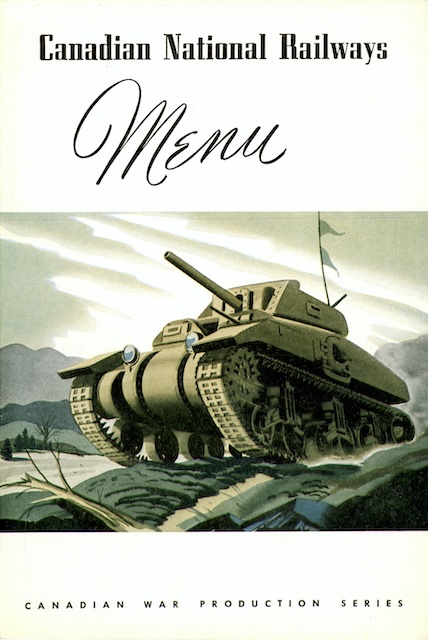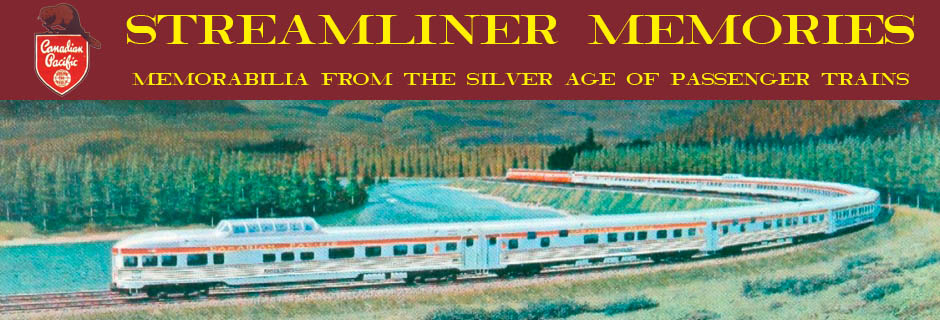Describing Canada’s army as “the dagger pointed at the heart of Berlin,” this menu lauds the “Ram,” a tank designed and produced in Canada and pictured on the menu cover. “The Ram is a 31-ton fortress armed with a tank-killing cannon, machine guns, bomb thrower, and smoke generator,” says the back of the menu. The menu doesn’t say so, but the tank had a railroad connection as it was manufactured by the Montreal Locomotive Works.
 Click image to download an 1.3-MB PDF of this menu.
Click image to download an 1.3-MB PDF of this menu.
The reality was less impressive than the description on the menu. Although more than 2,000 Ram tanks were built, they were never used in combat because they were considered inferior to the U.S.’s Sherman tank (which was manufactured by, among others, Lima, Baldwin, Alco, and Pullman). Not only did American assembly lines turn out Shermans faster than Canadians could make Rams, the Sherman “was undoubtedly a better operational tank,” admits an official history of Canadian armament production. Most of the Ram tanks produced were used exclusively for training and never saw a day of combat.
The other tank mentioned on the back of this menu, the Valentine, had been designed and mostly built in Britain, but 1,420 of them were built by Canadian Pacific’s locomotive shops in Montreal. None of these were used in combat by the Canadian army. Instead, with the support of the Communist Party of Great Britain, all of these relatively small, 18-ton tanks were shipped to the USSR as a part of the “aid to Russia” program.
The strange thing about this menu is that it was issued in March 1946, ten months after the end of the war in Europe. By then, it was clear that the Ram tank was a failure and neither it nor the Canadian army played any role in capturing Berlin from the Nazis. In describing the Canadian army as a dagger pointed at Berlin, could the menu have been referring to the Berlin that was partially controlled by the Russians? This appears unlikely since the menu praises Canadian industry for producing tanks that were sent to Russia.
The cover of the menu states that this is one menu in the “Canadian War Production Series.” So far, I haven’t seen any other menus in this series.
The inside of the menu had a stamp (which I digitally removed) that said it was part of the “Arthur H. Rumpf Menu Collection.” I’ve also seen this stamp on menus in the New York Public Library.
Rumpf was born in Evansville, Indiana in 1888 and worked for a wholesale grocer there before moving to Milwaukee where he worked as a broker, or middleman between food producers and retailers. His expertise in the grocery industry led him to be named director of the annual food exposition at the Minnesota State Fair.
Along the way he became interested in menus and before he died in 1954 he collected close to 40,000 menus used in various restaurants, hotels, ocean liners, and dining cars. He donated most of these to libraries such as Evansville’s Willard Library, Milwaukee Public Library, Indianapolis Public Library, and apparently the New York Public Library.
Today’s menu was used in a buffet car and was “meatless,” probably due to post-war rationing. It offered fruit or cereal with bread for 50¢, fruit or cereal with eggs and bread for 75¢, or fruit and cereal with fish or eggs and bread for $1. Coffee, tea, or milk was 5¢ extra. Multiply prices by 12 to approximate today’s U.S. dollars or by 17 to approximate Canadian dollars.
